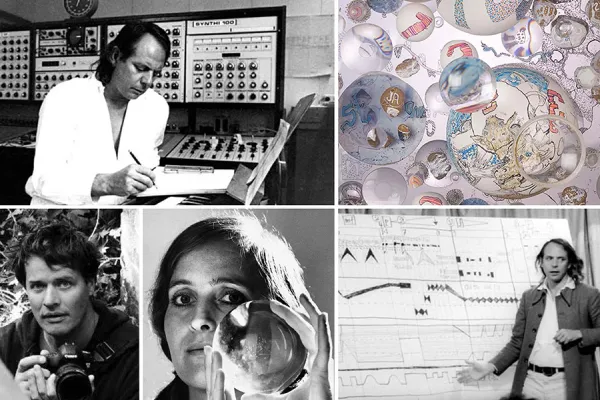Collaborations in Sound and Space: Artist Mary Bauermeister Headlines ArtsFest at Smith
Smith Arts

Published March 18, 2015
A pioneering artist will be on campus next week for a residency and a retrospective of musical compositions she helped to influence.
German visual artist Mary Bauermeister—whose signature work from the 1960s is now on exhibition at the Smith College Museum of Art —will take part in a celebration of electronic music composer Karlheinz Stockhausen, her husband and sometime collaborator.
Bauermeister and Stockhausen were married during a period in the 1960s when each produced signature work. Stockhausen died in 2007 at age 79.
Bauermeister, now 80, begins a weeklong residency at Smith Monday, March 23. An exhibition of her inventive sculptures, drawings and assemblages opened in January at the Smith College Museum of Art.
A documentary film about Bauermeister by Johann Camut will premiere on campus Wednesday, March 25, at 7 p.m. in Weinstein Auditorium as part of a three-day Smith ArtsFest. Two of the festival programs will feature the music of Stockhausen. All events are free and open to the public.
The theme of this year’s ArtsFest is the “fascinating artistic pairing” of Bauermeister and Stockhausen, said Greg Brown, artistic director of the Smith College Festival of Sound & Space, which is co-presenting the Stockhausen retrospective, along with SCMA and the Department of Music.
Brown said the two artists, both members of an avant-garde circle that met at Bauermeister’s studio in Cologne, Germany, were inspired by each other’s work. Stockhausen—considered one of the founders of modern electronic music—dedicated a number of his groundbreaking 1960s compositions to Bauermeister.
Several of the pieces created during that period will be performed during the three-day retrospective at Smith, including Zyklus (1959) for percussion, Klavierstück IX (1961) for piano, and the large-scale Hymnen (1966-67), which uses national anthems from around the world.
Stockhausen’s seldom-performed early choral works, Choral and Chöre für Doris, are also on the program.
In a not-to-be-missed musical moment, Bauermeister will perform an improvisational duet with Assistant Professor of Music Kate Soper on Tuesday, March 24, at 7 p.m. in Sweeney Concert Hall.
Soper, who counts herself as an admirer of Stockhausen’s music, said she’s looking forward to “leaping into the unknown” with Bauermeister.
“She’s a very interesting artist, and I’m eager to see how our duet interacts with the rest of the program,” Soper said.
The March 24 concert was organized by Liza Stepanova, Iva Dee Hiatt Visiting Artist in Piano at Smith. It features a choral ensemble of Smith students, faculty and guest artists conducted by Joseph Baldwin, Iva Dee Hiatt Distinguished Assistant Director of Choral Activities. Soloists include Stepanova and pianist Judith Gordon, associate professor of music; percussionist Avano Kataoka of the University of Massachusetts; and saxophonist Christopher Bartz from the University of Southern California.
Stepanova said she is excited about performing Stockhausen’s work for the first time—and about Bauermeister’s part in the concert.
“It very rarely happens that you have an improvisation by someone who knew the composer,” Stepanova said. “Music is also part of the exhibition at the museum.”
Planning for the retrospective began last year when Stockhausen scholar Paul Miller visited Smith in connection with the Bauermeister exhibition at the art museum, Stepanova said. Miller, who wrote an article for the exhibition catalog, shared his knowledge of how the two artists influenced each other’s work.
Creating the concert program was challenging at times, Stepanova said. For example, the original sound files for Stockhausen’s Gesang der Jünglinge—which means song of the youth—had to be acquired from the Stockhausen Foundation in Germany.
Stepanova said that piece, which was created from taped versions of boys singing, “should be particularly interesting to students because it is such a textbook example” of Stockhausen’s innovative composing methods.
“He is one of the most important composers of his generation,” Stepanova added. “We all study him as part of music history.”
For a complete schedule of ArtsFest events, visit http://www.smith.edu/smitharts/stockhausen.php.
Images (clockwise from top left) Karlheinz Stockhausen; Mary Bauermeister, German, born 1934. What 4, (detail),1968–69 Painted wood, glass, optical lenses, ink, watercolor, printed paper, and stones. Private collection; Johann Camut, documentary filmmaker; Portrait of Mary Bauermeister c. 1964 by Hans Namuth (born Germany, 1915–1990), Gelatin silver print; Karlheinz Stockhausen.